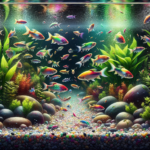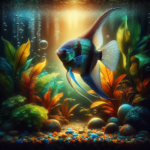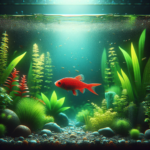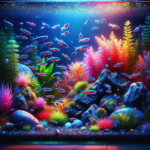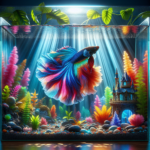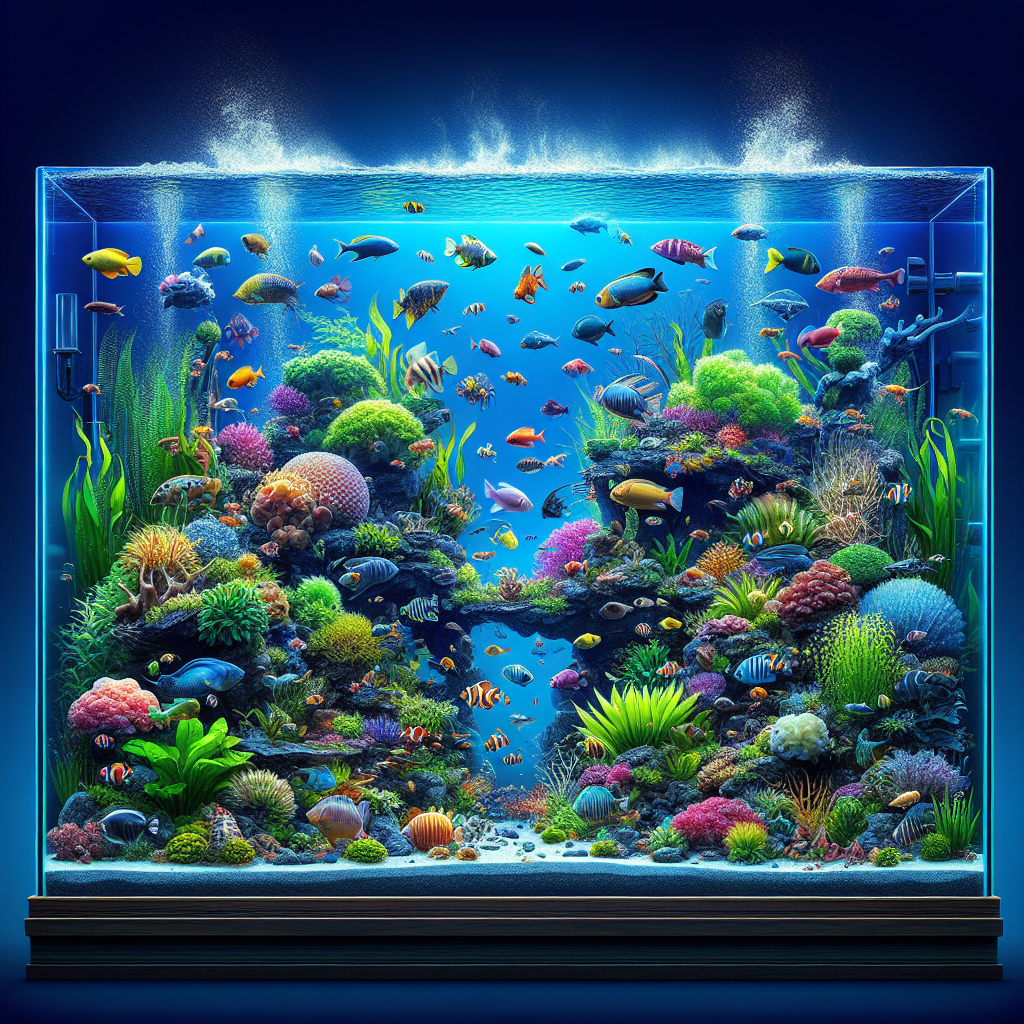
Key Takeaways
-
Choosing the right tank size is crucial; a 55-gallon tank is a good starting point for beginners.
-
Proper water circulation and filtration are essential for a healthy aquarium ecosystem.
-
Lighting enhances the beauty of your aquarium and is vital for plant and fish health.
-
Combining fish and plants requires understanding their compatibility and needs.
-
Regular maintenance, including water quality checks and tank cleaning, ensures a thriving aquatic environment.
Embarking on Your DIY Aquarium Journey
Creating a DIY aquarium is an adventure that blends art, science, and a touch of magic. It’s about more than just putting fish in a tank; it’s about crafting an ecosystem that thrives and brings beauty into your space. Whether you’re a seasoned aquarist or a curious newbie, let’s dive into the essentials of designing your underwater paradise.
What You Need to Know Before Starting
Before we submerge ourselves in the details, let’s get our feet wet with some foundational knowledge. An aquarium is more than a container of water; it’s a living, breathing environment. The key to success lies in understanding the balance of this ecosystem. You’ll need to consider the type of fish and plants you want to house, the chemistry of the water, and the equipment that will keep your tank running smoothly.
Benefits of a Customized Aquatic Space
Why go DIY with your aquarium? Because it gives you the freedom to tailor every aspect to your liking. From the size and shape of the tank to the selection of fish and decorations, every choice is yours. This customization not only ensures the health and happiness of your aquatic friends but also lets you express your creativity and style.
Aquarium Basics: Size Matters
One of the first decisions you’ll make is the size of your aquarium. It’s not just about the space it will occupy; it’s also about the environment you’ll be able to create for your fish and plants. A larger tank offers more stability in water conditions and more room for inhabitants, but it also requires more maintenance.
Selecting the Perfect Tank Size
-
Consider starting with a 55-gallon tank, which provides ample space for a variety of fish and decorations.
-
Think about the types of fish you want to keep; larger species or a greater number of fish will require more space.
-
Remember that the larger the tank, the more water you’ll need to change, and the more equipment you’ll need to maintain it.
When selecting a tank size, think about the future. It’s not just about what you want now, but what you might want down the line. Upgrading to a larger tank can be more complex than starting with one that’s adequately sized from the get-go.
Space Requirement and Placement Tips
Once you’ve chosen your tank size, it’s time to think about where it will live in your home. You’ll need a location that’s away from direct sunlight to prevent algae growth and somewhere with a stable temperature to keep your fish comfortable. Also, consider the weight of a filled aquarium; a gallon of water weighs about 8.34 pounds, so a 55-gallon tank will weigh over 450 pounds when filled. Make sure your floor can handle it!
Now, let’s move on to the technical side of things, where we’ll talk about water circulation and filtration—vital components of any thriving aquarium.
Lighting for Health and Beauty
Lighting in an aquarium is not just for aesthetic appeal; it’s essential for the health of your plants and fish. The right lighting can simulate the natural day cycle, encouraging plant growth and providing your fish with a comfortable habitat.
When selecting lighting for your DIY aquarium, consider LED lights. They’re energy-efficient, produce less heat, and come in a variety of spectrums to enhance the color of your fish and promote plant life. The general rule is to provide 1 to 2 watts of lighting per gallon of water for fish-only tanks and 2 to 5 watts per gallon for planted tanks.
Choosing Substrates and Decorations
Substrate isn’t just the floor of your aquarium; it’s the foundation of your underwater landscape. It supports plant life, houses beneficial bacteria, and contributes to the overall well-being of your aquarium’s inhabitants. For most setups, a layer of substrate about 2 inches deep is sufficient. Here’s what to consider:
-
For planted tanks, use a nutrient-rich substrate to provide essential minerals for plant growth.
-
Gravel or sand are popular choices, but ensure they are inert and won’t affect water chemistry.
-
Decorations like rocks, driftwood, and caves offer hiding places for fish and create a more natural environment.
Bringing Life to Your Aquarium
With the stage set, it’s time to introduce the stars of your aquatic show: the fish and plants. But before you rush to the pet store, it’s important to understand the type of environment you’re aiming to create. Freshwater and saltwater tanks have different requirements and offer different types of ecosystems.
Freshwater vs. Saltwater: Setting the Stage
Freshwater aquariums are generally easier to maintain and a great place to start for beginners. They require less stringent water conditions and offer a wide variety of fish and plants that are hardy and adaptable. Saltwater aquariums, on the other hand, open up a world of exotic fish and vibrant coral, but they demand more precise water conditions and equipment.
Fish and Plants: Creating the Perfect Mix
When selecting fish and plants, it’s crucial to consider compatibility and environment. Some fish prefer densely planted spaces, while others need open water to swim. Here are some tips:
-
Research fish species to understand their size, temperament, and environmental needs.
-
Choose plants that are suitable for your lighting conditions and can thrive in your water’s pH level.
-
Remember that balance is key; overcrowding can lead to stress and health issues for your fish.
Assembly Line to Aquatic Paradise
Now that you’ve got all your components, it’s time to assemble your aquarium. This is where you’ll see your vision start to come alive. Begin with placing your substrate, followed by your decorations, and then fill the tank with dechlorinated water.
Equipment Setup: A Step-by-Step Guide
Proper equipment setup is crucial for a healthy aquarium. Here’s how to get started:
-
Install the heater on one side of the tank and the filter on the other to ensure even heat and water distribution.
-
Place the lighting fixture on top of the tank, ensuring it covers the full length for even light exposure.
-
Arrange any additional equipment like air pumps or CO2 systems according to their instructions.
Remember to rinse all your equipment before placing it in the tank to remove any dust or residues that could harm your aquatic life.
Example: “When I set up my first planted tank, I made sure to evenly distribute the LED lights to avoid shadowed areas. This ensured that all my plants received equal light and grew uniformly.”
Water Preparation and Conditioning
Water quality is the lifeline of your aquarium. Tap water often contains chlorine and other chemicals harmful to fish and beneficial bacteria. Here’s what to do:
Use a water conditioner to neutralize these chemicals. Follow the instructions on the bottle for the correct dosage.
Cycle your tank before adding fish. This process involves running the tank with all equipment for a few weeks to establish beneficial bacteria. This bacteria will help break down fish waste and maintain a healthy nitrogen cycle.
Introducing Your Aquatic Inhabitants
Introducing fish to your tank is an exciting moment, but it must be done with care. Acclimate your fish by floating their bags in the tank water for about 15 minutes to equalize the temperature. Then, gradually mix some tank water into the bag over the next 15 minutes before gently releasing them into the tank.
Routine Maintenance: Keep Your Aquarium Thriving
Aquariums require regular maintenance to stay healthy. Neglecting this can lead to poor water quality and stressed, sick fish. So, let’s roll up our sleeves and get into the routine that will keep your underwater world pristine.
Regular Water Quality Checks
Testing your water regularly is essential for detecting any imbalances before they become problems. Aim to check your water parameters at least once a week. You’re looking for ammonia, nitrite, nitrate, pH, and hardness levels. Keep a log to track any changes over time.
Most importantly, don’t skip on water changes. Regularly replacing 10-20% of the tank water with fresh, conditioned water can help maintain a stable environment.
Feeding Practices and Nutrition Balance
Feeding your fish might seem simple, but there’s more to it than just sprinkling some flakes into the tank. Overfeeding is a common mistake that can lead to water quality issues. Follow these guidelines:
-
Feed your fish only as much as they can consume in a couple of minutes, once or twice a day.
-
Vary their diet with a mix of flakes, pellets, frozen, and live foods to ensure they get all the necessary nutrients.
-
Observe your fish during feeding to make sure they are all eating and to check for any signs of illness.
Cleaning Protocols and Equipment Upkeep
Cleaning your tank and equipment is a crucial part of maintenance. Algae can build up on the glass, substrates, and decorations, affecting the water quality and the tank’s appearance. Use an algae scraper for the glass, and remove any decorations for a thorough cleaning as needed.
Keep an eye on your filter, too. It should be cleaned monthly, depending on the manufacturer’s recommendations, to ensure it’s working efficiently.
With these steps and a little dedication, your DIY aquarium will not only be a stunning addition to your home but a thriving ecosystem that brings joy and tranquility to your space. Remember, patience is key in the world of aquascaping. Take the time to enjoy the process, and you’ll be rewarded with a breathtaking underwater paradise that you’ve created with your own hands.
Solving the Puzzle: Troubleshooting Tips
Even the most meticulously crafted aquariums can encounter challenges. It’s part of the journey. Being prepared to identify and address these issues will keep your aquatic paradise thriving.
Common Aquarium Challenges
Here are some typical hurdles you might face:
-
Algae overgrowth can be caused by excess nutrients or too much light.
-
Cloudy water might be a sign of bacterial bloom, overfeeding, or inadequate filtration.
-
Unexplained fish deaths can result from poor water quality, stress, or disease.
By regularly checking your water parameters and observing your fish’s behavior, you can catch most issues early and take corrective action.
Preventative Measures and Effective Solutions
Prevention is always better than cure. Here are some strategies to keep common problems at bay:
-
Maintain a regular cleaning schedule and avoid overfeeding to prevent algae and maintain water clarity.
-
Quarantine new plants and fish before adding them to your tank to prevent the introduction of diseases.
-
Invest in a good quality water test kit and use it regularly to keep an eye on your aquarium’s health.
If you do encounter problems, don’t panic. Research the issue, consult with fellow aquarists or a professional, and take measured steps to correct it.
Final Thoughts: Revel in Your Creation
Building and maintaining a DIY aquarium is a fulfilling hobby that blends creativity with a sense of responsibility. It’s about more than just the aesthetics; it’s about nurturing a living ecosystem that relies on your care.
Lessons Learned and Joy in Aquascaping
Every aquarium is a learning experience. You’ll learn about the delicate balance of life, the importance of consistency, and the joy that comes from creating something beautiful. Remember to take a step back from time to time and appreciate the tranquil world you’ve brought to life.
As your knowledge and skills grow, so will your confidence. Maybe you’ll expand your aquatic collection or help others start their own. Whatever path you choose, know that the world of aquascaping is as rewarding as it is enchanting.
Frequently Asked Questions
Got questions? Here are some answers to common queries that might be bubbling up in your mind.
Can I Convert My Old Aquarium into a Saltwater Tank?
Yes, you can convert a freshwater tank to a saltwater one, but it requires thorough cleaning and new equipment suitable for saltwater maintenance. Research and preparation are key to making this transition successful.
How Often Should I Feed My Fish?
Most fish thrive on being fed once or twice a day. Only give them as much food as they can consume in a few minutes. Overfeeding can lead to water quality issues and health problems for your fish.
What Are the Signs of Poor Water Quality?
Cloudy water, strong odors, and algae growth can all indicate poor water quality. Fish may also show signs of stress or illness, such as lethargy, loss of appetite, or erratic swimming.
Is It Possible to Overfilter My Aquarium?
While filtration is crucial, too much can disturb the habitat of your fish and plants. Choose a filter rated for your tank size and monitor the current to ensure it’s not too strong for your aquarium’s inhabitants.
How Can I Make My Aquarium More Energy-Efficient?
Opt for LED lighting, use a timer to control the light cycle, select energy-efficient pumps and heaters, and maintain your equipment to ensure it’s running optimally. These steps can help reduce energy consumption and save on costs.
In conclusion, your journey into DIY aquarium design is a path of continuous learning and joy. With each new discovery and milestone, you’ll find that the underwater world you create is a reflection of your dedication and passion. So, immerse yourself in the process, and watch as your aquarium evolves into a living work of art that mesmerizes and inspires all who gaze upon it.
